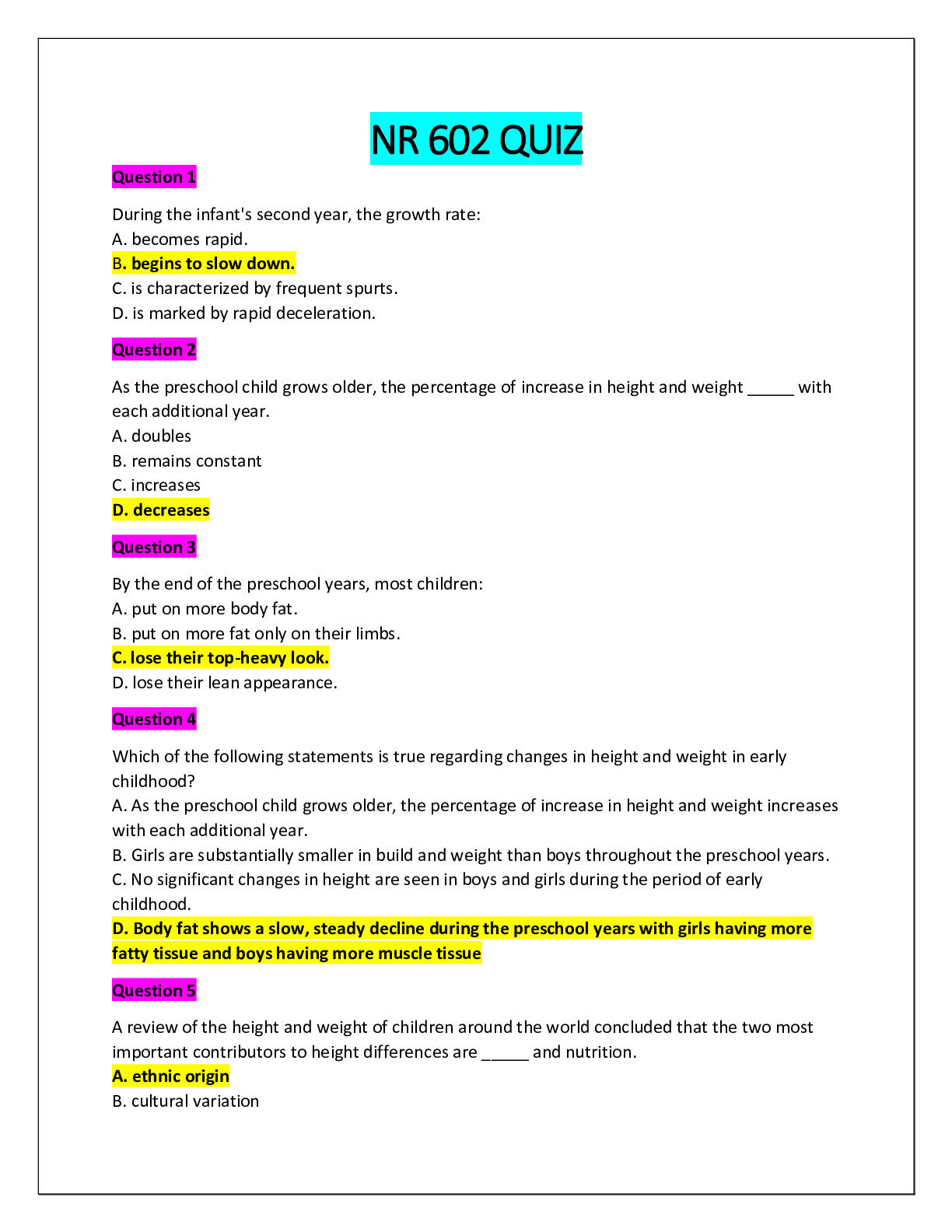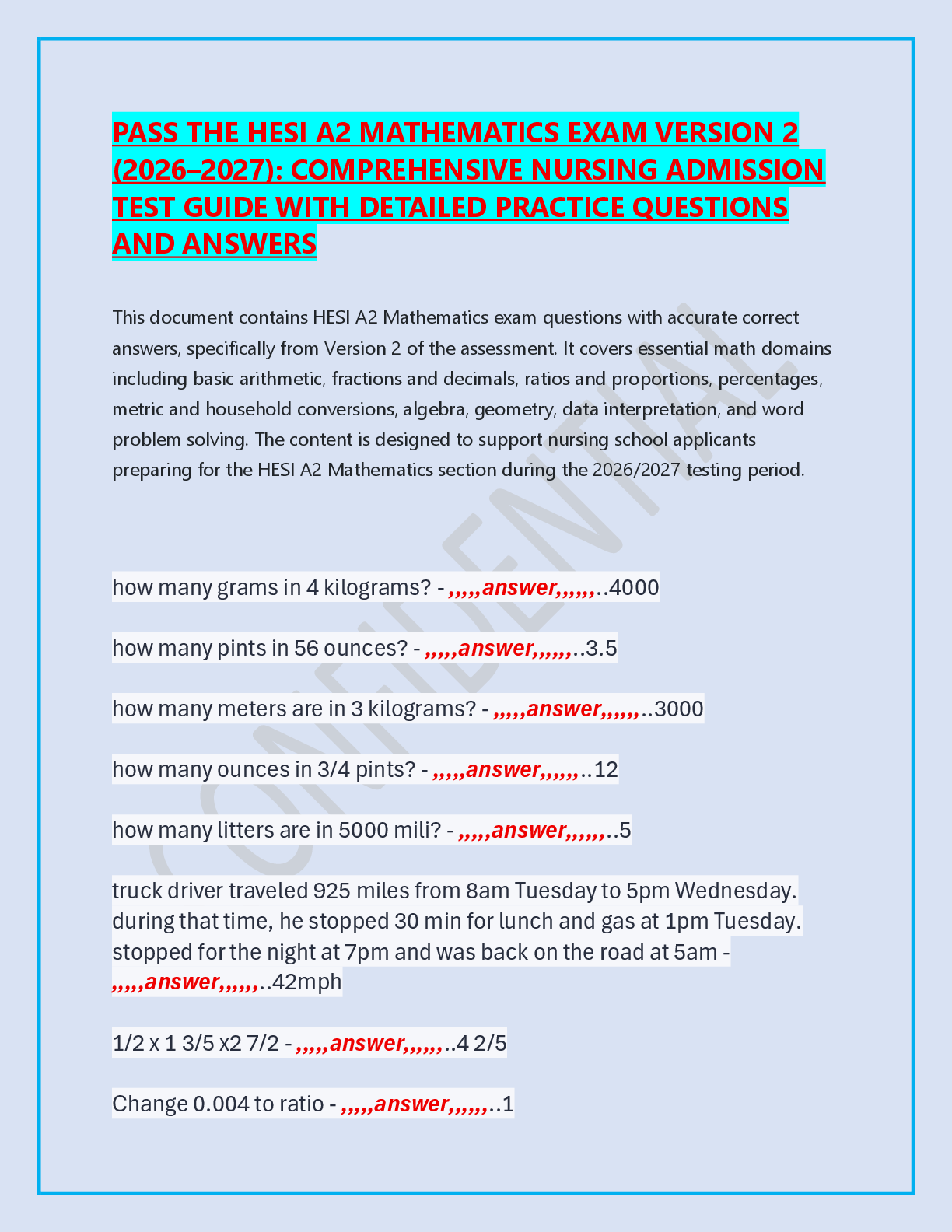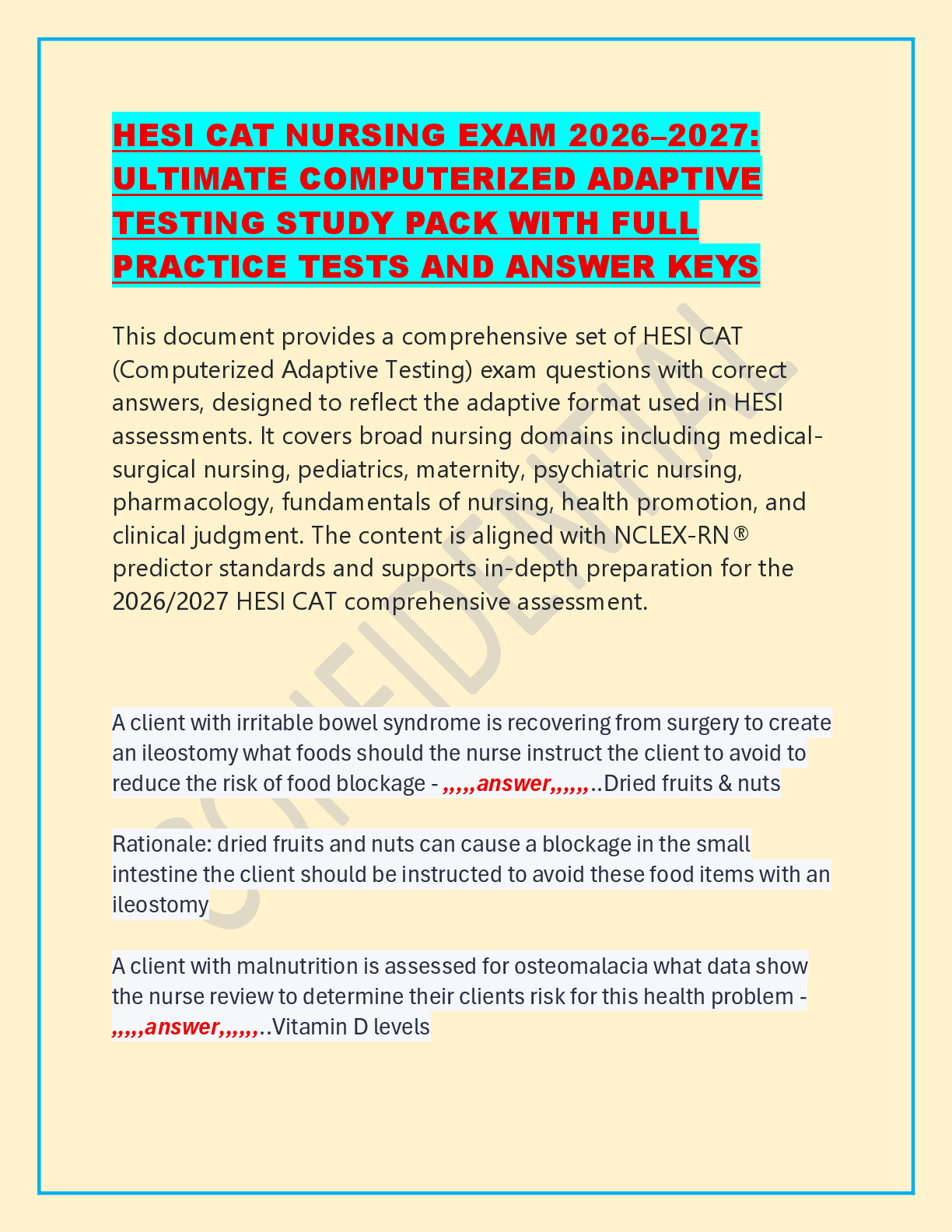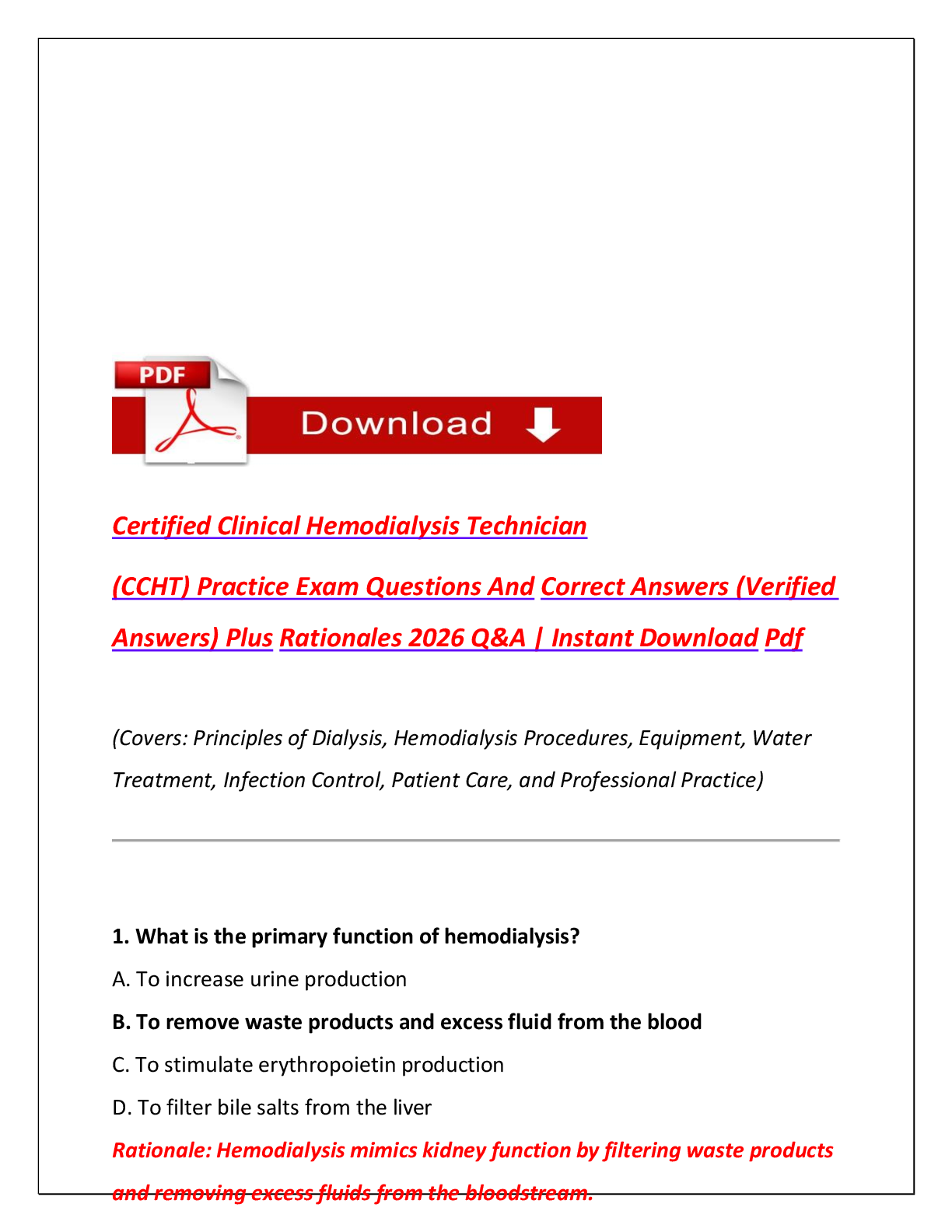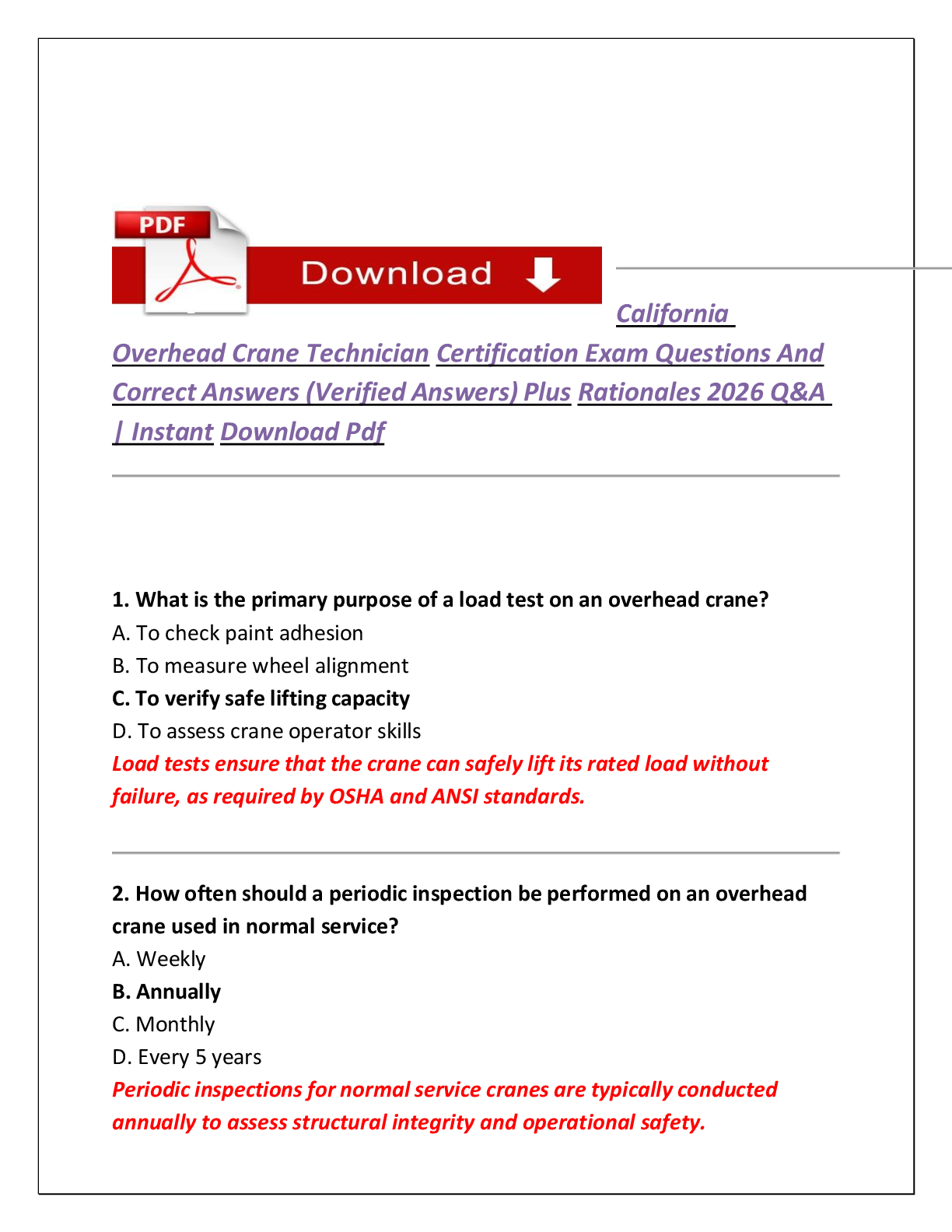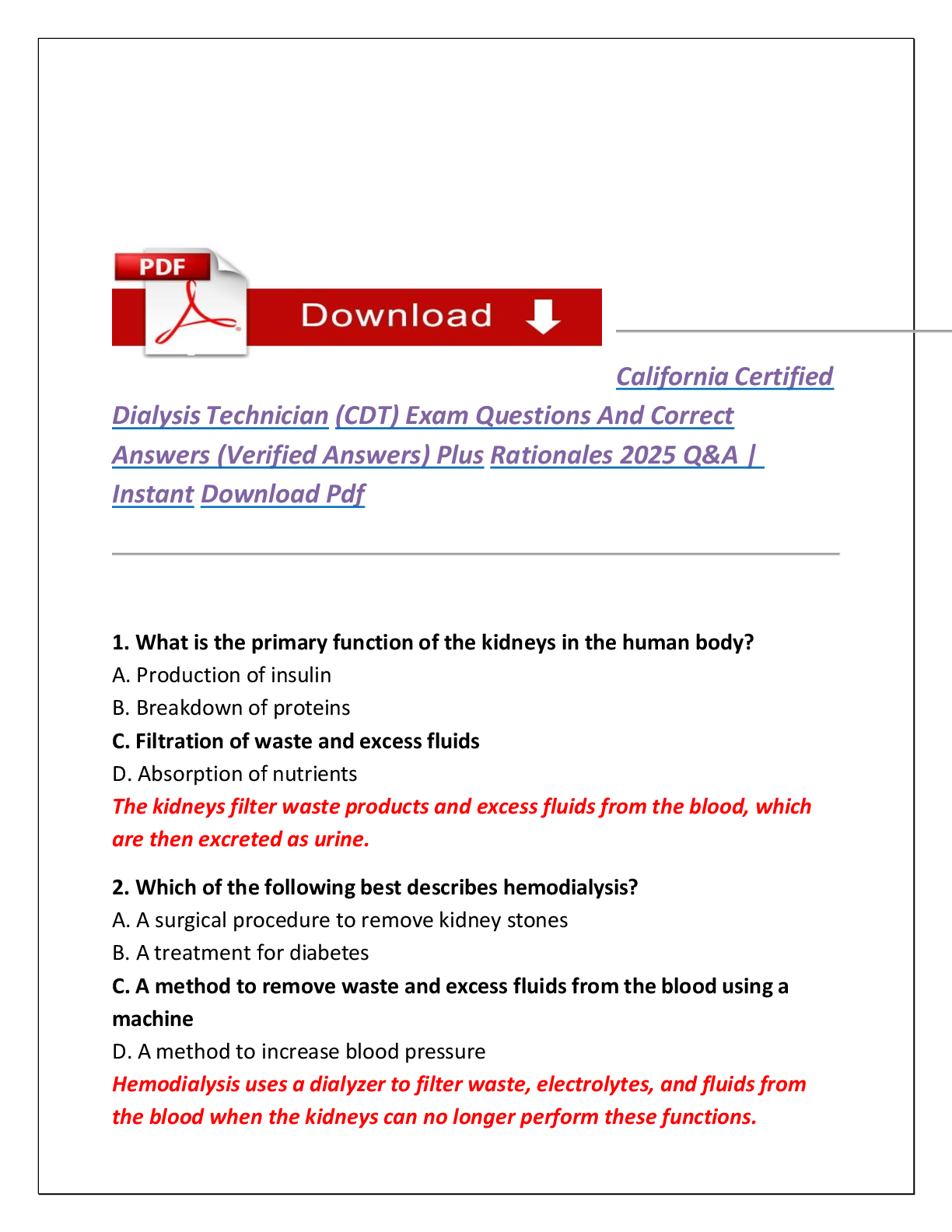Psychology > EXAM > PSYC 290N WEEK 2: INFANCY – QUIZ (All)
PSYC 290N WEEK 2: INFANCY – QUIZ
Document Content and Description Below
PSYC 290N WEEK 2: INFANCY – QUIZ Question 1 2 / 2 pts (TCOs 3 and 5) What is the name of the process of creating new synapses that happens very quickly in the first couple of years after birth ... ? Synaptic pruning Synaptomiosis Myelinization Correct! Synaptogenesis Chapter 4, page 86 Question 2 2 / 2 pts (TCOs 3 and 5) What is the name of the sheath around the axons that serves as insulation and speeds neural transmissions? Fontanel Glial fiber Correct! Myelin Dendrite Chapter 4, page 88 Question 3 2 / 2 pts (TCOs 3 and 5) An infant's sleep/wake cycle lasts approximately how long? 30 to 45 minutes 4–6 hours Correct! 2 hours 8 hours Chapter 4, page 88 Question 4 2 / 2 pts (TCOs 3 and 5) which of the following is true regarding colic? Almost all infants develop colic. Colic is a pattern of intense daily periods of crying for 1 to 3 hours per day. The cause of colic is usually an allergy to infant formula. Correct! Colic typically begins at about 2 weeks of age and then disappears spontaneously at 3 or 4 months of age. Chapter 4, page 89 Question 5 2 / 2 pts (TCOs 3 and 5) Moesha and Nick have a newborn. If their baby is an average infant, by his first birthday he will have had which of the following? Measles Several instances of sleep apnea No illnesses whatsoever Correct! Seven respiratory illnesses Chapter 4, page 93 Question 6 2 / 2 pts (TCOs 3 and 5) Seth is 6 weeks old. You are holding three balloons in your hand: one red, one blue, and one green. Which of the following statements is most likely true? Correct! Seth has already developed the required cones in his eyes to differentiate between the three different colored balloons. Because Seth is only 6 weeks old, he can only distinguish between red and green. Seth probably only has the rods for blue vision in his eyes, so he won't be able to distinguish between red and green. At this age, Seth's cones are still too underdeveloped for him to distinguish any colors at all. Chapter 4, page 98 Question 7 2 / 2 pts (TCOs 3 and 5) Researchers determine an infant's interest in an object by measuring which of the following? Whether or not they look directly at the object Correct! How long they look at the object. Whether or not they show signs of boredom such as yawning Whether or not they smile at the object Chapter 4, page 100 Question 8 2 / 2 pts (TCOs 3 and 5) Vernon is a 14-month-old toddler. His family laughs when he waves bye-bye because he seems to be waving at himself. Piaget would attribute this twist on the bye-bye wave to which of the following ideas? Children learn gestures through object permanence. Deferred imitation is impossible until age 2 or later. Correct! Children simply imitate what they see. Caregiver involvement dictates the level of sensory development. Chapter 5, page 111 Question 9 2 / 2 pts (TCOs 3 and 5) Which of the following terms is used to describe a strategy in which researchers move an object in a way that the infant does not expect? Violation of object permanence method Correct! Violation-of-expectations method Violation of object concept method Violation of experience method Chapter 5, page 113 Question 10 2 / 2 pts (TCOs 3 and 5) Tina babbles and her mother responds to her by imitating the sounds Tina makes. This would appear to refute the belief that Correct! early language is the result of reinforcement of correct sounds. early language is an example of stimulus-response theory. language acquisition results from imitation. language is based on fundamental operating principles. Chapter 5, page 117 Question 11 2 / 2 pts (TCOs 3 and 5) Rodney is focusing on the individual sounds, rhythm, and intonation of the language his family speaks. How old is Rodney? 20 weeks Correct! 8–9 months 12 months 18 months Chapter 5, page 123 Question 12 2 / 2 pts (TCOs 3 and 5) Eric caught on to his relation to other people very early in life. Rather than talk about "doggie" and "ball," Eric focused on people, using pronouns such as "you" and "me." Katherine Nelson would refer to this as which type of style? Correct! An expressive style A receptive style A referential style An ambiguous style Chapter 5, page 124 Question 13 2 / 2 pts (TCOs 3 and 5) According to your text, some researchers suspect that among infants, which of the following might be a good predictor of later intelligence test scores? Types of object permanence Correct! Rates of habituation Levels of accommodation Referential language Chapter 5, page 126 Question 14 2 / 2 pts (TCOs 3 and 5) C.J. gains comfort through eating and drinking. She also cries to gain attention from her parents or to express discomfort. Freud would say that C.J. is in which stage of development? Symbiotic Dependent Anal Correct! Oral Chapter 6, page 132 Question 15 2 / 2 pts (TCOs 3 and 5) Chad cries and his mother responds immediately. When he coos at his mother, she smiles and cuddles him. Developmentalists would say that this is an example of which of the following? Maternity Correct! Synchrony Multiplicity Duplicity Chapter 6, page 134 Question 16 2 / 2 pts (TCOs 3 and 5) Callie, age 11 months, went to the circus with her mother. When a clown came bouncing up to Callie's stroller, Callie was anxious and looked at her mother. When Callie's mother began to laugh at the clown, Callie joined in the laughter. Callie's behavior is called affective regulation. Correct! social referencing. stranger anxiety. bonding dependence. Chapter 6, page 136 Question 17 2 / 2 pts (TCOs 3 and 5) Julie's mother is extremely busy with her job, which she does at home. Some days, Julie's mom is responsive and attentive, other days she is so overwhelmed by work that she is emotionally unavailable. Which of the following attachment styles is Julie likely to develop? Secure and ambivalent Correct! Insecure and ambivalent Insecure and detached Insecure and disorganized Chapter 6, page 138 Question 18 0 / 2 pts (TCOs 3 and 5) At what age do self-conscious emotions typically arise? Correct Answer 18 months You Answered 30 months 34 months 36 months Chapter 6, page 146 Question 19 2 / 2 pts (TCOs 3 and 5) Which of the following statements about social development and day care is true? Correct! Children in nonparental care seem to have a higher rate of insecure attachment than children with exclusively maternal care. Children in nonparental care show no substantive differences in attachment from children cared for exclusively by their parents. There is a heightened risk of insecure attachment in children placed in day care after the age of 1. Parental behaviors are more associated with social development if the day care arrangements are unstable. Chapter 6, page 148 Question 20 2 / 2 pts (TCOs 3 and 5) Jaslin is a caregiver in a local day care. Parents often describe her as involved, positive, and responsive to the children. Jaslin would be defined as what type of caregiver? Sympathetic Knowledgeable Well organized Correct! Sensitive Chapter 6, page 150 Question 21 8 / 10 pts (TCOs 3 and 5) Clarify some of the advantages and disadvantages of growing up in a bilingual household. Your Answer: Advantages They can speak two languages or more languages. They have appreciation for other languages and culture. They might get a job that requires one of the languages their know. They can easily learn a new language. Study suggest that the onset of dementia is delayed in bilingual patients. they can learn new words easily. they have good listening skills. The joy of knowing more than one language. Disadvantages having difficulties in successful completion of a formal education. They may not get a job that requires being bilingual. bilinguals have more 'tip of the tongue' moments than monolingual speakers. the verbal skills of bilingual is weaker than monolingual. Speech hinderance in children. Pronunciation of new words in a new language become more difficult. The sadness of knowing just one language. See Chapter 5, page 125. There are clear advantages in metalinguistic abilities (capacity to think about language) and a greater ability to focus attention on language tasks. The cons are bilingual children reach some language milestones later and the possibility of language memory difficulties in adulthood. [Show More]
Last updated: 3 years ago
Preview 1 out of 19 pages

Buy this document to get the full access instantly
Instant Download Access after purchase
Buy NowInstant download
We Accept:

Reviews( 0 )
$7.00
Can't find what you want? Try our AI powered Search
Document information
Connected school, study & course
About the document
Uploaded On
Sep 23, 2021
Number of pages
19
Written in
All
Additional information
This document has been written for:
Uploaded
Sep 23, 2021
Downloads
0
Views
142

